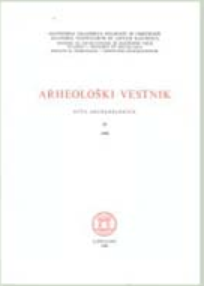Steklene zajemalke iz severnega emonskega grobišča
Povzetek
This article on glass ladles is limited to a discussion of the material from the northern cemetery of Emona, which was excavated during the years 1961—19681. Although few in number, glass ladles from the northern cemetery occupy an important place in the total glass inventory, in comparison with other sites in Slovenia and the rest of Yugoslavia, Italy and the western Roman provinces. With the growth of the glass industry in the middle of the 1st century, glass products began to replace pottery vessels and often imitated terra sigillata services and even oil lamps. This tendency can also be seen in the case of glass ladles. At the end of the 1st century they were everywhere replacing the more expensive and less readily available bronze and silver ware. In contrast to other sites — Pompeii, Cologne and the Styrian cemeteries2 — where several ladles have horizontally affixed handles (trulla), all ladles from the northern Emona graveyard have vertically affixed handles. A typological and chronological classification of ladles from the northern cemetery can be fairly accurately made on the basis of grave units and other grave goods. One of the oldest is a light green ladle, whose ringed base and semi-spherical bowl completely correspond to the bronze ladle found in the same grave (pl. I, fig. I)3. Chronologically, this ladle belongs to the first half of the 1st century, perhaps to Claudius’s reign, which is confirmed by the terra sigillata plate, type Ritt. 1, and the spherical ceramic bottle. A confirmation of the accuracy of the chronological classification of this kind of ladle can be found in grave 4084, where a similar form can be seen in the light green ladle, which was found together with a sigillata cup, type Drag. 24/24, which cannot be later than halfway though the 1st century. A chronologically later type of ladle are those with semi-spherical or cylindrical bowls without a ringed foot. Grave goods of terra sigillata plates, type Drag. 17b5 (pl. I, fig. 2) and thin-walled cups with a barbotine ornamentation date this type of ladle into the period of the Flavii, in the second half of the 1st century. The third, typologically and chronologically youngest form of ladle are those with irregular, at times wavy, semi-spherical or cylindrical bowls, and are found together with objects from the end of the 1st or beginning of the 2nd centuries. A somewhat shoddily produced form with irregular walls supports the idea that these ladles were produced locally, especially as they were the most numerous in the northern cemetery of Emona. We find them in graves dating from the transitional period at the end of the 1st and beginning of the 2nd centuries and some examples are also to be found in graves from the middle of the 2nd century6 (pl. I, fig. 4, 5, 6, 7). As was mentioned at the beginning, the actual number of glass ladles in comparison with the large quantity of other glass objects is small. There are a total of 19 ladles, which is an exceptionally large number in comparison with other sites, as a few similar examples are known only from Numag at the mouth of the Rhine, Vindonissa, Colchester and Vechten (Roman Fectioy. Very little is known about the origin of glass ladles from Emona. Those from the first half of the 1st century with a ringed base are certainly imports from northern Italy or the southern Mediterranean. The same can be said of the dark green ladle, although this belongs to the second half of the l ts century8. Those ladles classified in the third group, with irregularly formed bowls, are undoubtedly local products, although we do not as yet have any tangible proof that glass-making was a trade practised here. We could also theorise that their place of origin was northern Italy (Aquileia) where most products of the 1st and 2nd centuries came from. We find glass ladles in Emona only in cremation graves of the 1st and 2nd centuries. They are not found at all among the grave goods of the skeleton graves, neither have they been found within the town of Emona itself, from which we may conclude that glass ladles were only in use in the 1st and 2nd centuries and were used in the presentation ceremonies at cremation burials.
Prenosi
Prenosi
Objavljeno
Kako citirati
Številka
Rubrike
Licenca

To delo je licencirano pod Creative Commons Priznanje avtorstva-Nekomercialno-Deljenje pod enakimi pogoji 4.0 mednarodno licenco.
Avtorji jamčijo, da je delo njihova avtorska stvaritev, da v njem niso kršene avtorske pravice tretjih oseb ali kake druge pravice. V primeru zahtevkov tretjih oseb se avtorji zavezujejo, da bodo varovali interese založnika ter da bodo povrnili morebitno škodo.
Podrobneje v rubriki: Prispevki





